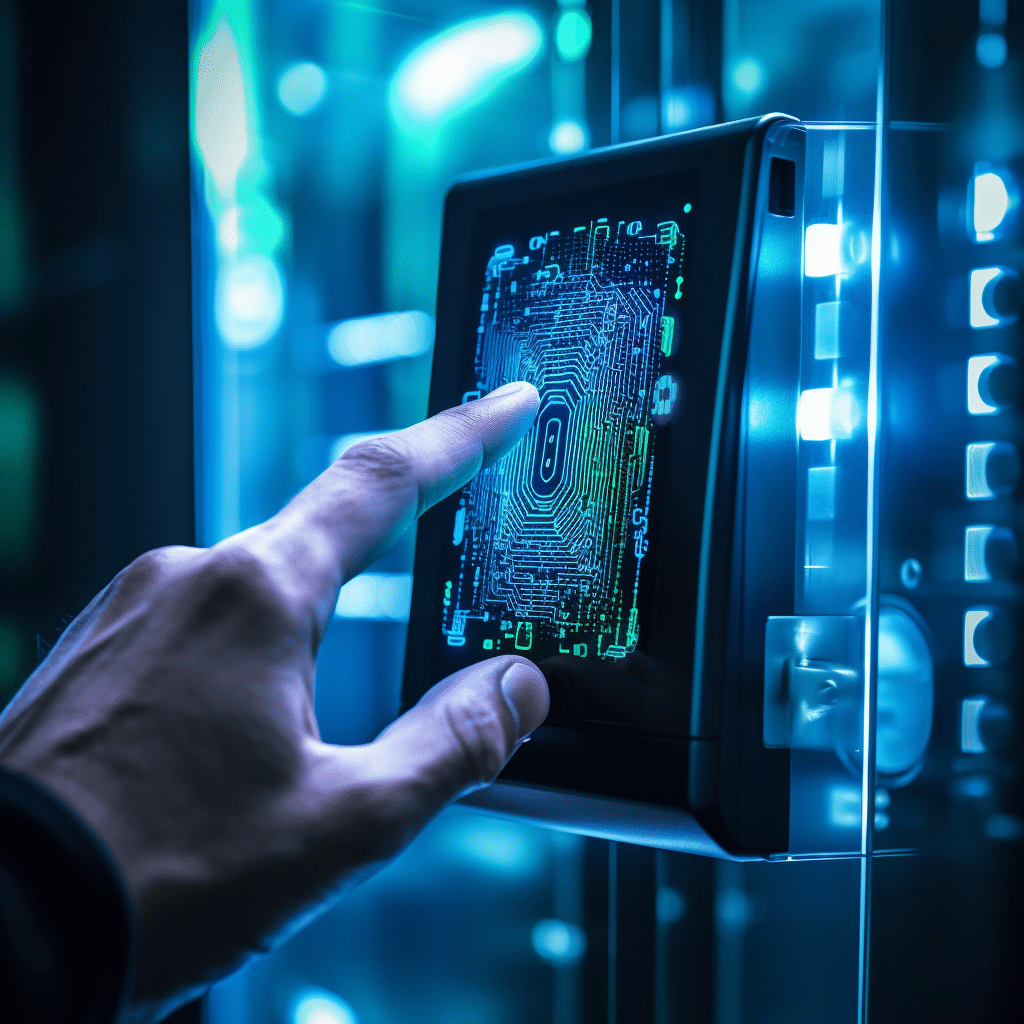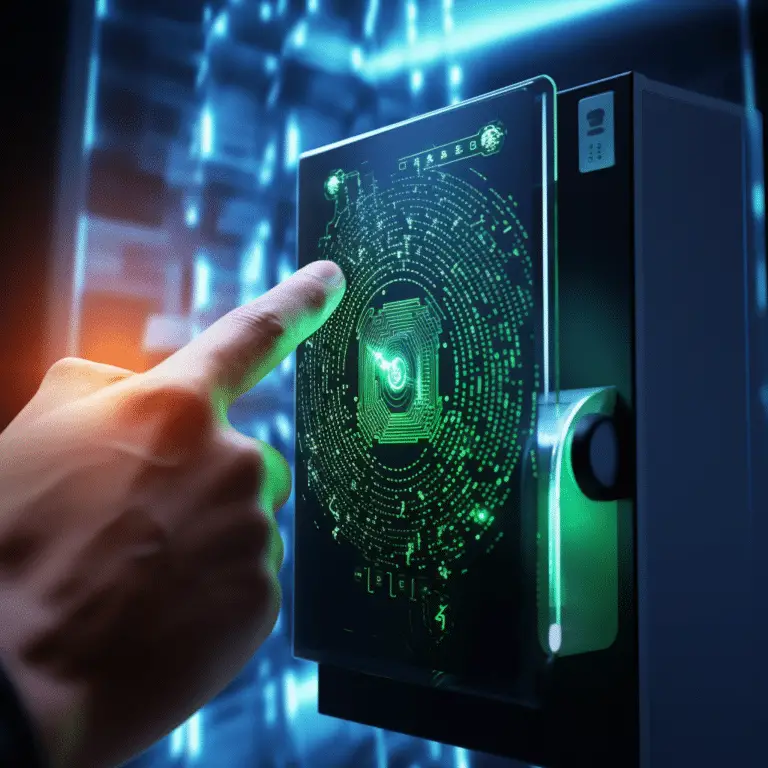Biometric access control systems provide numerous advantages that enhance security, accuracy, and efficiency in various institutions. These systems utilize unique physiological or behavioral characteristics, such as fingerprints, iris patterns, or facial features, to grant access to authorized individuals.
The advantages of biometric access control system include increased security by eliminating the need for traditional identification methods that can be easily forged or stolen. They also offer improved accuracy through the use of unique biometric traits that are difficult to replicate. Furthermore, biometric access control systems streamline the access process, eliminating the need for keys or access cards and enhancing overall efficiency in institutions.
Key Takeaways:
- Biometric access control system enhance security by eliminating the risk of forged or stolen identification methods.
- These systems offer improved accuracy by using unique biometric traits that are difficult to replicate.
- Biometric access control system streamline the access process, eliminating the need for keys or access cards.
- They are highly versatile and scalable, suitable for various applications and institutions.
- Implementing biometric access control system can result in long-term cost savings for institutions.
Enhanced Security
cure means of preventing these types of incidents by utilizing unique physiological or behavioral characteristics to verify the identity of individuals. This eliminates the risk of unauthorized access through easily forged, stolen, or shared passwords, PINs, or access cards. Biometric traits such as fingerprints, iris patterns, or facial features are inherently difficult to replicate, ensuring that only authorized individuals are granted access. This advanced level of security is especially important in sensitive areas or institutions where the protection of valuable assets, confidential information, or restricted areas is critical.
The Role of Biometric Authentication
Biometric authentication plays a crucial role in enhancing security within access control system. By relying on individuals’ unique biometric traits, the system verifies their identity with a high level of accuracy. This reduces the likelihood of unauthorized individuals gaining access, as the chances of replicating or falsifying biometric traits are exceedingly low.
The use of biometric authentication also eliminates the need for individuals to remember and manage multiple passwords or access cards, which are often shared or easily forgotten, leading to vulnerabilities. Instead, the system securely stores and matches the biometric data, providing a convenient, efficient, and secure means of access control.
| Advantages of Biometric Authentication | Challenges of Traditional Identification Methods |
|---|---|
|
|
The Advantages of Biometric Access Control Systems
Biometric access control systems have many benefits for security, accuracy, and efficiency. They use unique physical or behavioral traits like fingerprints or facial features to allow authorized individuals access. These systems improve security by replacing easily forged or stolen identification methods. They also increase accuracy by using traits that are hard to replicate. Biometric access control systems simplify access without keys or cards, making institutions more efficient overall.
Improved Accuracy
Biometric access control systems are more accurate than traditional identification methods. Biometric traits are unique and hard to copy, which reduces the risk of mistakes. These systems use biometric identification, such as fingerprints or iris patterns, to verify the identity of individuals. This ensures that only authorized people can enter. Unauthorized individuals who may have stolen or forged traditional identification methods are prevented from gaining access.
“Biometric access control systems provide improved accuracy in verifying the identity of individuals, minimizing the risk of false positives or mistaken identity.”
With biometric identification, institutions can have confidence in knowing that only authorized individuals are granted access, enhancing security measures and reducing the potential for security breaches.
| Advantages | Traditional Identification Methods | Biometric Access Control Systems |
|---|---|---|
| Accuracy | Higher risk of false positives or mistaken identity | Improved accuracy in identifying individuals |
| Security | Higher risk of forged or stolen identification methods | Enhanced security by eliminating the need for traditional identification methods |
| Efficiency | Time-consuming access process with keys or access cards | Streamlined access process without the need for physical keys or access cards |

Overall, the improved accuracy of biometric access control system ensures that authorized individuals are granted access while minimizing false positives or unauthorized entry. This enhances security measures, making biometric access control systems a reliable and effective solution for institutions.
Streamlined Access Process
Biometric access control system offer a streamlined access process that enhances convenience and efficiency for individuals accessing secure areas. By eliminating the need for physical keys, access cards, or passwords, these systems simplify the access procedure and reduce the time and effort required for individuals to gain entry.
Biometric access control systems allow individuals to use their fingerprints, iris patterns, or facial features for access. This eliminates the need for keys or passwords. Individuals can easily gain access using their unique biometric traits.
Using biometric access control systems reduces the risk of lost or stolen access cards or keys. This improves security and efficiency by reducing administrative efforts needed to replace and reprogram access credentials.
Enhanced Convenience and Efficiency
Biometric access control systems are more secure than traditional methods. They use unique physical or behavioral characteristics to verify identity, making it hard for unauthorized access. Unlike passwords or access cards, biometric traits like fingerprints are hard to copy. This ensures only authorized people can access sensitive areas with valuable assets or confidential information.
| Benefits | Biometric Access Control Systems | Traditional Access Control Methods |
|---|---|---|
| Convenience | ✓ | ✗ |
| Efficiency | ✓ | ✗ |
| Security | ✓ | ✗ |
In conclusion, the streamlined access process offered by biometric access control systems revolutionizes the way individuals access secure areas. With enhanced convenience and efficiency, these systems simplify the access procedure, reduce administrative efforts, and improve user satisfaction. By eliminating the need for physical keys, access cards, or passwords, biometric access control systems provide a seamless and secure access experience.
Versatility and Scalability
Biometric access control systems offer unparalleled versatility and scalability, making them ideal for a wide range of applications and institutions. These systems can be seamlessly integrated into various settings, including corporate offices, educational institutions, healthcare facilities, and government organizations. Whether it’s a small business or a large enterprise, biometric access control systems provide the flexibility to adapt to different environments and security levels.
Biometric access control systems can be customized to fit the needs of different organizations. They can adjust security levels and access permissions for different user groups. Biometric systems are also scalable, so institutions can expand their security infrastructure as they grow. This ensures that the system remains effective and efficient as the organization changes.
| Benefits of Biometric Access Control Systems | Versatility | Scalability |
|---|---|---|
| Customizability | Allows for customization to match unique requirements | Enables easy expansion as the organization grows |
| Wide Range of Applications | Can be implemented in various settings | Adapts to different environments and security levels |
| Flexible Access Permissions | Configurable access permissions for different user groups | Easily accommodates a larger number of users |
In conclusion, the versatility and scalability of biometric access control system make them an ideal choice for institutions seeking an advanced and adaptable security solution. With the ability to customize the system to meet specific needs and easily scale it up as the organization grows, biometric access control system provide unparalleled flexibility and efficiency.
Cost Savings in Biometric Access Control Systems
Implementing biometric access control system can result in significant cost savings for institutions. While the initial investment may be higher compared to traditional access control methods, the long-term benefits far outweigh the cost. By eliminating the need for physical keys or access cards, biometric systems reduce the expenses associated with replacing lost or stolen cards and reprogramming access codes.
Biometric access control system can save money by reducing administrative costs. Traditional systems require managing access cards or passwords, which is time-consuming and expensive. Biometric systems eliminate this need by using unique biometric traits. This saves administrative resources and reduces expenses.
Biometric systems are also convenient and efficient, leading to indirect cost savings. There are no physical keys or access cards to distribute, so entry is quicker and easier. This improves productivity and reduces delays or disruptions, saving resources for institutions.
Table: Cost Comparison – Traditional Access Control vs. Biometric Access Control
| Cost | Traditional Access Control | Biometric Access Control |
|---|---|---|
| Hardware | Lower upfront cost | Higher upfront cost |
| Replacement | Costly for lost/stolen cards | Eliminated |
| Administrative | High costs for credential management | Reduced or eliminated |
| Productivity | Potential delays or disruptions | Improved efficiency |
Biometric access control system use unique physical or behavioral characteristics for authorized individuals to access institutions. They’re highly secure and minimize unauthorized access. These systems are more accurate than traditional methods and reduce administrative costs, leading to long-term savings. Organizations can enhance security, accuracy, and efficiency while saving costs with biometric access control system. Managing access control can improve security and save money.

Conclusion
They can be implemented in various institutions, from government agencies to private companies, and can accommodate a large number of users. This makes them a cost-effective and practical solution for organizations of all sizes.
In summary, biometric access control system offer enhanced security, accuracy, and efficiency by utilizing unique physiological or behavioral characteristics to ensure that only authorized individuals are granted access. They provide a highly secure and reliable identification method, streamline the access process, and are versatile and scalable for use in various institutions.
Applications can be used in different settings, from small businesses to big companies. They can adjust to different environments and security levels.
Finally, while the initial investment for biometric access control system may be higher, they result in long-term cost savings. By eliminating the need for physical keys or access cards, institutions can reduce the expenses associated with replacing lost or stolen cards and reprogramming access codes. Additionally, these systems reduce administrative costs by streamlining the management of access credentials.
In conclusion, the advantages provided by biometric access control systems, including enhanced security, improved accuracy, streamlined access processes, versatility, scalability, and cost savings, make them invaluable tools for institutions seeking unparalleled security, accuracy, and efficiency.
FAQ
What is a biometric access control system?
A biometric access control system is a security system that uses unique physiological or behavioral characteristics, such as fingerprints or iris patterns, to grant access to authorized individuals.
How does a biometric access control system enhance security?
Biometric access control systems enhance security by eliminating the need for traditional identification methods that can be easily forged or stolen. They rely on unique biometric traits that are difficult to replicate, ensuring that only authorized individuals can gain access.
How do biometric access control systems improve accuracy?
Biometric access control systems improve accuracy by using unique biometric identification, such as fingerprints or iris patterns, to verify the identity of individuals. These traits are difficult to replicate, reducing the risk of false positives or mistaken identity.
How do biometric access control systems streamline the access process?
Biometric access control systems streamline the access process by eliminating the need for physical keys, access cards, or passwords. Individuals can simply use their unique biometric traits for access, simplifying the process and enhancing convenience and efficiency.
Are biometric access control systems suitable for different institutions?
Yes, biometric access control systems are highly versatile and scalable, making them suitable for various applications and institutions, including corporate offices, educational institutions, healthcare facilities, and government organizations.
How can biometric access control systems result in cost savings?
Although the initial investment for biometric access control systems may be higher, they can result in cost savings in the long run. These systems eliminate the need for physical keys or access cards, reducing the costs associated with replacing lost or stolen cards. Additionally, they reduce administrative costs related to managing access credentials.

